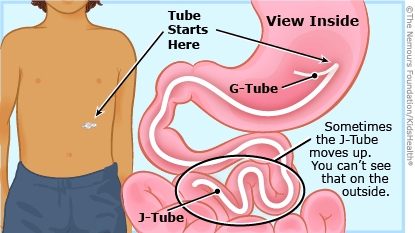Gastrojejunal (G-J) Tube Dislodgement: How to Care for Your Child
Even with all of the right care, a gastrojejunal tube (G-J tube) sometimes gets dislodged (comes out of place).


A G-J tube goes through the skin of the belly, into the stomach, then into the jejunum, the second part of the small intestine. When a G-J tube comes out of place, it might be because either the G-tube portion is no longer correctly located in the stomach, or the J-tube portion is no longer in the jejunum. If the tube is out completely, it is important to replace it quickly so the hole in the skin does not begin to close. If the tube is out part of the way or has moved on the inside so that it is no longer in the jejunum, it must be adjusted so that feeds go to the correct place safely. Children can dislodge a G-J tube by pulling on it, rolling over during sleep, or getting it caught on something.
Your child's G-J tube has been replaced and has been checked by the health care provider. The G-J tube is now working normally and is safe to use.

-
Wash your hands before touching or caring for the G-J tube.
-
Keep the area around the stoma (hole) clean and dry.
-
Apply prescription creams or ointments as directed.
-
You may want to put mittens on your child's hands before bed to keep your child from pulling on the tube while sleeping.
-
Prepare your child's feeds and medicines as directed by your health care provider. Medicines should generally be given through the G-tube part. Check with your health care provider to make sure you know what to give through the G-tube and J-tube parts.
-
If the health care provider prescribed antibiotics, make sure your child takes all of the medicine as directed.
-
Do not rotate or turn the tube — this can cause the tube to twist or the stoma to get too big.
-
Always keep the feeding set tubing out of the way of infants and children. There is a risk that the feeding set tubing can get wrapped around a child’s neck, which could lead to strangulation or death.

-
The G-J tube comes out or the length of the tube has changed.
-
The G-J tube is clogged and you cannot clear it with gentle flushing.
-
Your child has a fever or signs of infection, such as redness, swelling, warmth, pus, or foul-smelling discharge.
-
There is leakage of fluid on the skin around the stoma or a rash around the stoma.
-
There is bleeding from the stoma.
-
There is soft, moist, pink-red tissue (called granulation tissue) coming out from around the tube site.
-
Your child develops diarrhea.
-
Your child has coughing or choking with feeds.

Your child: